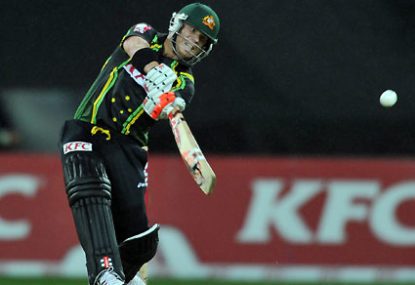Expert

David Warner’s explosive switch-hit six against India in the first Twenty20 clash at ANZ Stadium on Wednesday night has rattled a goodly few cages.
The inevitable negative narks are already labelling the shot as a form of cheating.
Utter bollocks.
Even former Test captain Mark Taylor, who is far removed from being a nark, rates the switch-hit as “terrific TV, and skilful, but unfair”, which is a long way short of cheating.
So Warner has polarised the cricket fraternity. But why?
The bowler has first chop at the action, and can bowl faster or slower with off-cutters or out-swingers. The batsman never knows what he’s going to face.
But as soon as the batsman changes his normal stance to equate the battle between ball and bat, he’s cheating or unfair.
As it happens, Taylor would have been more adept than most had he tried switch-hitting during his stellar career.
Taylor was a world-class left-handed batsman who couldn’t play golf left-handed if his life depended on it. So he plays right-handed off a single-figure handicap.
Switch-hitting would have been right in his wheel-house.
Former keeper Rod Marsh is exactly the same story.
Former England all-rounder Brian Close was a left-handed bat who played golf both left and right-handed – left off a 5 handicap, right off 6. Close had a mixture of left and right-handed clubs in his allowable 14-club bag.
He was never ever stymied.
Let’s make one fact clear: Warner’s not the switching-hitting pioneer. That honour belongs to Pakistani Mushtaq Mohammad playing for Northamptonshire in the mid ’70s. But the traditionalists poo-barred the shot, so Mushtaq canned it.
Mike Gatting tried it against the bowling of Allan Border in the 1987 World Cup final – and that was that.
It was left to England’s Kevin Pietersen to reinvent what was originally tagged the reverse sweep.
Playing against New Zealand in a ODI in 2008, right-handed Pietersen deposited Scott Styris over the fence twice with left-handed swats. The negative narks had a field day, joined at the time by former fast bowlers Sir Richard Hadlee and Michael Holding.
But Sir Vivian Richards thought it was great, bringing a new dimension to the game.
The same arguments are going on right now. It’s sensational when a switch-hit comes off, but it’s a high risk shot. There’s a fine line between being a hero facing the next delivery, and a goose heading for the shed.
And while all this rubbish is being bandied about, what about the ramp shot, also known as the paddle scoop or Marillier – the ability to get the bat under the ball and flick it on its way to third man or fine leg?
Ramping is also a high-risk shot. But even the negative narks seem to have accepted its existence.
So let’s get on with it. Bowlers stop being so precious, just keep bowling straight at the body at yorker length, giving no width.
Fail with the latter and there’s a distinct possibility of being switch-hit.
And there’a nobody to blame but the bowler.